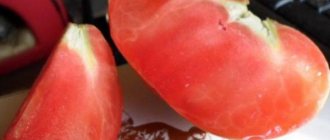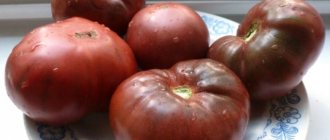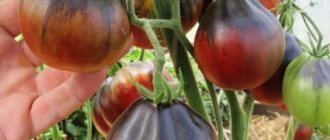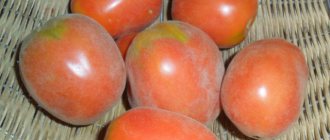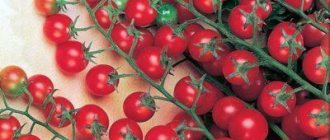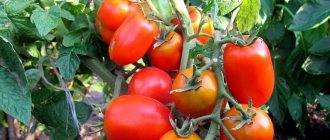Modern tomato hybrids are very popular among gardeners because they produce rich harvests and are resistant to temperature changes and diseases. One of these varieties is Ivanych F1, bred by Siberian breeders. If you follow all the necessary instructions and growing rules, the result will not take long to arrive.
The article provides all the necessary information about the hybrid, which will be useful to the gardener: characteristics, features of cultivation and agricultural technology, reviews from summer residents.
Brief information about the variety
- Fruits and bush : the shape of the fruits is round, in the phase of technical maturity they are bright pink or crimson. Average weight – 180-200 g. The plant is determinate, height – 60-70 cm.
- Productivity : about 18-19 kg of tomatoes are harvested from 1 m².
- Resistance : the plant is cold-resistant and tolerates sudden temperature changes. It has high resistance to nightshade diseases.
- Distribution : Moscow and Leningrad regions, the territory of the Far East and the Urals, Altai Territory.
- Application : fruits are added to salads, first and second courses, juices, ketchup, lecho and tomato paste are prepared from them. The medium-sized fruits tolerate heat treatment well, so they are suitable for canning as a whole, as well as for pickling and pickling.
- Planting : seedling method. Depending on the growing method, sowing seeds for seedlings is carried out at different times. In case of subsequent transplantation into a greenhouse - at the end of February or beginning of March. When planting tomatoes in the garden - in the second half of March or early April. Planting pattern – 40x50 cm.
- Soil : light, loose, enriched with organic and mineral fertilizers, well-drained and slightly acidic.
- Care : regular watering, fertilizing with nitrogen and phosphorus-potassium fertilizers. Does not require gartering or pinching.
- Ripening period : ripening is uniform, occurs 90-95 days after emergence. Long-term storage of fruits is possible.
Description of tomato Ivanych f1 and recommendations for growing
Tomato Ivanych f1 tolerates temperature changes well and is resistant to diseases and infections. The variety, according to reviews, is characterized by high yield and excellent fruit performance.
Ivanovich tomatoes are easily transported, stored, and require little care.
Summer residents try to plant seedlings of this variety in their gardens so that they can eat fresh tomatoes, make juice, and prepare salads all season long.
Description of tomato Ivanovich
The variety is suitable for planting in open ground and greenhouses. The bushes grow small, quite strong and productive. Tomatoes of this variety are universal, since they can be used to prepare pickles, preserves, and tomato juice, which is very thick and contains a large amount of vitamins, microelements, and organic compounds.
The characteristics and description of the variety are as follows:
- tomato Ivanych belongs to the first generation of hybrid varieties;
- belongs to the mid-early group: if you plant the seeds in the ground and then transfer the seedlings to a greenhouse or beds, then after 3 months you can get the first fruits;
- determinate bushes, reaching a height of 60-70 cm (this is the maximum height);
- there is not much foliage on the plants;
- the bush forms clusters containing 5-6 tomatoes;
- from 1 m² you can harvest, according to reviews from gardeners, 12-18 kg of Ivanych f1 tomatoes;
- the number of tomatoes harvested depends on care: fertilizing, regular watering, fertilizing.
Photos of tomatoes of the Ivanych variety show that the fruits are quite large, their average weight is 200 g. Among other features of tomatoes, it is worth noting the following:
- round or round-flat shape;
- there is a small ribbing, which is located near the stalk;
- the structure is dense;
- the skin that covers the fruit is glossy, elastic and thin;
- The pulp is juicy, not watery, there are few seeds.
Tomatoes of the Ivanych variety are distinguished by their sugary, sour-sweet taste and pleasant aroma. The fruits change color depending on ripening: first the tomatoes become pale, then green, gradually acquiring a rich pink-scarlet color.
How are tomatoes grown?
Productivity depends on the region in which the variety, which was created by scientists from Siberia, was planted. Tomatoes can be grown in regions where unfavorable conditions prevail. For example, a short summer sets in, then a sudden heat or cold snap sets in.
Those gardeners who grew Ivanych f1 tomatoes leave positive reviews. They advise sowing tomatoes for seedlings on the 15th-20th of March or early April. But this period will not work if the gardener wants to plant seedlings in a greenhouse. In this case, it is recommended to plant the seeds in the ground in early March. The soil for the variety is formed from sand, peat, and turf soil.
Seeds must be soaked in a special growth stimulator for 10-12 hours before planting. Ivanovich tomato seedlings should be planted in containers, deepening the seeds 2 cm into the soil. After this, the soil should be lightly sprinkled with warm water and covered with film.
The pots should be placed in a warm place until the first shoots appear. As soon as the sprouts come out, you need to place the containers on the windowsill or under fluorescent lamps. Watering should be done once every 5 days.
Gardeners advise planting in the ground - greenhouse or open - only after picking the leaves. Wood ash or phosphate should be placed in the holes. The bushes do not need to be tied up after they have been planted, but only fed and watered once every 6 days. Mineral fertilizers should be used as fertilizers.
Characteristics of the variety
The plant is determinate, mid-early - the first harvest occurs 3 months after emergence.
Description of the bush
The tomato bush Ivanovich has the following characteristics:
- height – 60-70 cm;
- stems are massive, thick, foliage is medium;
- leaves are large, dark green;
- 5-6 tomatoes are formed on one brush.
Description of fruits
Tomatoes have the following characteristics:
- round shape;
- in the phase of full biological maturity, tomatoes acquire a bright pink or crimson color;
- average weight – 180-200 g;
- the pulp is juicy, non-watery, sweet with slight sourness, has a small number of seeds;
- The skin is dense, so the fruits can easily withstand transportation without losing their high taste and presentation.
Productivity
Tomato Ivanych F1 has a good yield: if you follow all the rules of agricultural technology, you can harvest about 18-19 kg of tomatoes from 1 m².
Growing regions
The fruits are versatile in preparation.
The plant is cold-resistant and tolerates sudden temperature changes. Regions of distribution - Moscow, Leningrad regions, the territory of the Far East and the Urals, Altai Territory.
Application area
The fruits are suitable for fresh consumption - they are added to salads. They are used to prepare first and second courses, juices, ketchup, lecho and tomato paste. Medium-sized tomatoes tolerate heat treatment well, so they are suitable for canning as a whole, as well as for pickling and pickling.
ᐉ Tomato “Ivanych” F1: description of the variety and main characteristics of the tomato – orensad198.ru
Tomato Ivanovich was obtained by Transnistrian breeders. The variety withstands alternating hot and cold days, as well as short-term drought.
The hybrid looks like this:
- The bush is of determinate type, the stem reaches a length of 70 cm.
- The plant has a moderate amount of leaves. The plates are large and the same shape as most tomatoes.
- The fruits are large in size, each weighing up to 200 g.
- The variety is endowed with a round shape with slightly prominent ribs in the area of the stalk.
- Up to 5 fruits ripen in one cluster. The first of them are filmed at the end of July.
- As the tomato ripens, it turns pink.
- There are no spots on the stalk, which is clearly visible in the photo.
- There are few seeds inside the pulp.
- The tomato has a bright, balanced taste.
- The fruits are used fresh, juice and paste are prepared. Tomatoes are suitable for preparing for the winter in the form of pickles.
| Mid-early | Determinate-minant | Universal | For open ground and greenhouses | 180-200 | Up to 20 | Pink | Round, medium density, excellent taste |
Preparing and planting seedlings
The optimal growing method is seedlings. Containers tightly filled with soil are suitable as containers. Caring for seedlings is not complicated, step by step:
- plant tomato seeds in containers with soil to a depth of 1.5-2 cm;
- spray the planting with warm water;
- cover with film until the first shoots appear;
- the room temperature should be at least 20 degrees;
- after the sprouts appear, remove the film and provide the tomatoes with a constant source of light;
- Watering should be done at least once every five days;
- After the first leaves appear, it is necessary to pick the seedlings.
Planting tomatoes in open ground usually occurs at the beginning of the summer season - the first days of June. In greenhouse conditions, earlier is the beginning of May. It is recommended to harden the variety first. The soil for plants must be prepared. Each hole is filled with ash or superphosphate in moderate quantities.
Advantages and disadvantages
Tomato Ivanovich has acquired a special favor among gardeners due to the following positive characteristics:
- The low stem makes it easy to care for.
- The tomato forms an ovary in any weather.
- High yield - up to 5 kg are harvested from a bush per season.
- The fruits are large and ripen quickly.
- The variety is immune to most tomato diseases.
- The plant develops equally well in the garden in the beds and in the greenhouse.
- The skin is dense and glossy. Does not crack in wet weather or during transportation.
- The tomato is attractive in appearance and does not wrinkle during transportation.
Attention! The hybrid maintains productivity both in areas with long, warm summers and in cool areas.
Among the shortcomings on reviews, there is disappointment in taste.
Features of cultivation, planting and care
Sowing seeds for seedlings is carried out 50-55 days before the intended planting in the ground. Seedlings dive at the stage of two true leaves. When planting seedlings in a permanent place per 1 sq. per meter of plot, it is recommended to place up to 4 plants when forming 2-3 stems.
Further care for tomatoes consists of timely watering, fertilizing with complex mineral fertilizer, pinching and preventive measures to protect against diseases and pests.
Formation of undersized tomatoes, tying and protection from diseases, video
If you grew Ivanych f1 tomatoes, please write whether they met your expectations in terms of yield and taste of the fruit? How did you shape the bush? Briefly describe the advantages and disadvantages of this tomato in your opinion. If possible, attach a photo of the fruit or the entire bush to the comment. Thank you!
Your reviews of the Ivanych tomato and additions to the description will help many gardeners evaluate this hybrid objectively and decide whether it is worth planting or not.
Features of agricultural technology
The presented tomato will not require much attention. The hybrid is easily grown in dachas, which are visited on weekends.
Young plants are planted in the garden after frost has passed. Afterwards they carry out work common to all crops: loosening the soil, watering, fertilizing. A determinate tomato does not need to form a bush. It is only necessary to remove unnecessary stepsons, and after the formation of the ovary, excess leaf plates. This way the plant is well ventilated and illuminated by the sun.
There are always a lot of weighty fruits on the clusters. Due to high load, the stems may break off, so timely gartering is required.
Attention! Although the hybrid is resistant to diseases, do not forget about preventive measures.
Variety care
Like all hybrids, the buttocks of the Ivanych variety are quite demanding on the composition of the soil. Therefore, it is recommended to systematically add organic additives. If you feed the bushes well, loosen the soil and drive out weeds, you can get larger fruits and, accordingly, a richer harvest.
Tomatoes are quite resistant to viral infections, but it is necessary to take preventive measures against fungal infections. Young bushes can be sprayed with a weak solution of potassium manganese. To ensure that the bushes are strong enough, it is better to resort to the help of special preparations. Fortunately, tomatoes are grown in a greenhouse, so it should be constantly ventilated.
Reviews
- Maria from Belgorod. I planted a tomato on the plot last season. I grew the seedlings myself and cared for them according to all the rules. By the end of July, low bushes stood out in the beds, literally completely covered with large pink tomatoes. They were eaten in salads and stored for the winter.
- Tatyana from Tula region. Last winter, a friend “treated” the seeds of the early hybrid Ivanych. Since our summer is not too warm, I plant tomatoes in the garden under an agrotex tunnel. I did the same with this variety. The plants developed quickly and well. The harvest was not received as early as the manufacturer promised, but in large quantities. The tomato is attractive in appearance, so the surplus was sold.
- Stepan from Krasnodar region. Everything is good in the hybrid, but the taste is disappointing. Neither sweetness nor sourness is clearly felt, so the main part went for processing.
Tomato Ivanovich is a variety successfully grown in various areas.
Following the rules of agricultural technology, anyone will receive an excellent harvest.
Tomato Ivanych f1: description of the hybrid, photos of tomatoes and bushes, reviews from beginners and experienced gardeners
Modern tomato hybrids are very popular among gardeners because they produce rich harvests and are resistant to temperature changes and diseases. One of these varieties is Ivanych F1, bred by Siberian breeders.
If you follow all the necessary instructions and growing rules, the result will not take long to arrive.
The article provides all the necessary information about the hybrid, which will be useful to the gardener: characteristics, features of cultivation and agricultural technology, reviews from summer residents.
Advantages and disadvantages
Among the advantages of tomatoes of the Ivanych variety are:
- cold resistance;
- excellent taste and aroma of fruits;
- almost 100% seed germination;
- resistance to nightshade diseases;
- no need for gartering and bush formation.
The disadvantages of the variety include increased demands on the composition and fertility of the soil. The second disadvantage is that it is problematic to collect seeds for further growing tomatoes from your own harvest.
Seeds are easy to collect, but reusing them is not advisable, because... in the second generation, the maternal characteristics are split and the resulting plants will have completely different properties.
Advantages and disadvantages
| Advantages | Flaws |
|
|
Growing seedlings
Depending on the growing method, sowing seeds for seedlings is carried out at different times:
- for transplanting into a greenhouse - at the end of February or beginning of March;
- when planting tomatoes in the garden - in the second half of March and early April.
Seed preparation
You can purchase seeds of this variety at any gardening store. Buy quality material that has not expired.
Before sowing, the seeds need to be discarded, which will increase the percentage of their germination. They are poured into any deep container and filled with saline solution (1 teaspoon of salt per 1 liter of water). After half an hour of soaking, the bad seeds will float to the surface, and the good ones will sink to the bottom. They are removed, washed under water, then dipped in a raspberry solution of potassium permanganate.
The disinfection procedure lasts 30 minutes. Then the seeds are washed again and sprayed with a solution of a growth stimulator (Epin, Zircon).
The last procedure: the seeds are kept in a damp cloth for 48 hours. During this time they will swell and hatch. To avoid drying out, they need to be placed in a cool and shaded place and sprayed several times.
Seeds are germinated at elevated temperatures (+25-27); in a cool place, the germination process is delayed for several days.
Preparing the container
The main requirements for seedling containers are a height of at least 10 cm and the presence of drainage holes.
You can use a wooden box, a plastic container or disposable containers (200 ml plastic cups, peat pots). When grown in a disposable container, there is no need to plant the sprouts, which eliminates the risk of injury.
By the end of 60-65 days of growing the seedlings in them, peat cups completely fall apart. They can be used as a last resort only after picking seedlings.
Priming
According to the description, tomatoes of the Ivanych variety grow well in light, loose, fertile and slightly acidic soil. A purchased substrate for growing vegetable seedlings will be optimal. You can also use homemade soil mixture. To do this you need to mix several ingredients:
- garden soil;
- rotted manure;
- coarse sand;
- wood ash.
Proportions – 2:1:1:1.
For cultivation you need to prepare fertile soil
Instead of sand, some use sawdust from fruit trees. If the soil is too acidic, it is worth adding a handful of dolomite flour, chalk or slaked lime.
Before planting, the soil is calcined in the oven or watered with boiling water/raspberry solution of potassium permanganate.
Technology
The planting container is filled with soil mixture and compacted, retreating 2-3 cm from the top. When sowing in groups, make furrows at a distance of 4-5 cm from each other, then lay out the seeds, keeping a distance of 3-4 cm between them.
When sowing in cassettes, disposable cups or peat pots, make indentations. Place 1-2 seeds in each. The optimal sowing depth is 1 cm. If you sow the seeds deeper, they will take longer to germinate, and some of them may not hatch at all.
The crops are sprinkled with a thin layer of a mixture of sand and earth, then irrigated with a spray bottle and covered with transparent glass or film.
Growing conditions
For good germination of crops, optimal conditions must be provided:
- stable temperature within 25-26 °C;
- humidity about 60%;
- diffused daylight for 4 hours a day;
- to avoid the formation of condensation inside the greenhouse, seedlings must be ventilated periodically (every day for 30 minutes);
- remove weeds;
- Irrigate with warm water as the soil dries.
If these conditions are met, in a week you can expect a massive emergence of seedlings, after which you need to immediately remove the shelter and move the crops to a cool but well-lit place. The seedlings are kept there for 5 days so that they grow the root system and do not stretch out, and then they are returned to their original place.
At the stage of appearance of the first two true leaves, picking is carried out. The crops are watered with water, an hour later the seedlings are removed and, together with a clod of earth, planted in disposable cups. The lack of soil is made up for with a mixture of humus and garden soil (1:1).
In order for the seedlings to take root better in a new place, they should be sprayed with a solution of urea or nitrophoska - 15 g per 10 liters of water. 20-30 ml of working solution is poured under each plant.
Best reviews from our readers
- Victor
Of all the hybrids tested, this one turned out to be the best. The first collection is a bucket per square meter.
- Valera
I’m happy with the result, I didn’t take into account the foliage, late blight hit
- Tatiana
I really liked the variety, the fruits are strong, pink on top, but bright red inside, very juicy, there are a lot of them on the bush. I liked the fact that it can be stored for a long time when ripe. I’ve been growing it for 2 years now, I plan to plant it next year too, I’ve already purchased seeds
- Tatiana
Grown in 2022. They met expectations: tasty, sugary, good presentation - smooth and quite a lot. I plan to plant in the future.
- Tatiana
I grew it in 2015 and really liked it. I wanted to plant it in 2016, but I couldn’t find the seeds.
TomatLand7 139 views Rating of those who grew it: 3.38 out of 5
You can buy “Ivanych” tomato seeds from the seller
Transfer
Tomatoes Ivanych F1 are transplanted after 10 days of hardening. In the greenhouse - in early May, in open ground - in the second half of the month. Accustoming to fresh air is carried out gradually: the seedlings are taken outside in the first half of the day and kept there for 2-3 hours, each time increasing the time they spend in the fresh air.
Preparing the bed
The further growth of tomatoes, the quality and quantity of the harvest largely depend on the choice of planting site. Tomatoes of this variety are recommended to be planted after legumes, root vegetables and all varieties of cabbage. Choose a sunny place where there is no wind.
The best predecessor for tomatoes in an amateur garden is a cucumber, because... A lot of organic fertilizers are applied to it. Under production conditions, the best predecessor for tomato is legumes: clover, alfalfa.
The soil is loose, slightly acidic and well-drained. All preparatory work is carried out in the fall:
- the bed is cleared of weeds and vegetation residues;
- sprinkle with fertilizers - rotted manure or compost (10 kg), wood ash (3 kg), superphosphate (100 g) and potassium nitrate (80 g) per 1 m²;
- After this, deep digging is carried out.
In the spring, 2 weeks before planting, the prepared area is sprayed with a urea solution to destroy all overwintered parasites and pathogens. Preparation recipe: 15 g of the substance is dissolved in 10 liters of water.
To disinfect the soil, use a strong 3% urea solution - 300 g per 10 liters of water.
Planting scheme
Easy to care for plants
This plant has a compact above-ground part, so it does not require much space on the site. The optimal scheme for planting tomatoes is 40x50 cm, 6-7 bushes per 1 m².
Dig holes according to the size of the root system and water with water (1 liter each). After absorbing moisture, the roots are lowered into the holes, sprinkled with soil without fertilizers, and covered with peat.
The nuances of growing in open ground and in a greenhouse
Growing tomatoes in open ground and in a greenhouse has its own characteristics.
An important aspect when growing tomatoes in open beds is watering. Water the plants at the root without touching the leaves. It is better to do this a couple of hours before sunset.
When growing tomatoes in a greenhouse, pay attention to its lighting. The greenhouse should let in maximum light and protect plants from temperature changes.
Important. Many gardeners recommend covering the greenhouse with two layers of polyethylene to give the tomatoes additional protection.
Do not forget about treating the greenhouse against pests and diseases - greenhouse conditions are ideal for their reproduction.
It is advisable to water tomatoes in a greenhouse not in the evening, but in the morning. When watering late, condensation forms, which negatively affects the tomatoes.
Care
Caring for tomatoes of the Ivanych F1 variety is simple and consists of several activities.
In the first 3-4 days, tender bushes require shade from the sun to protect them from burns. Any covering material will do (for example, burlap or agrofibre). At night, the plantings are covered with film to prevent them from freezing.
White agrofiber (Agrospan, Spunbond) not only protects plants from the sun, but also from low temperatures.
Watering
Regular soil moisture is necessary. The further growth and productivity of the bushes will depend on the quality and quantity of watering. The first time this is done a week after transplanting the plants into the garden bed. 1 liter of warm, settled water is poured under each bush. Further watering is carried out as the top layer of soil dries.
Be sure to water Ivanych tomatoes at the beginning of the flowering period and in the fruit-filling phase. Water is poured under the root from a watering can or jar to eliminate the risk of burning and rotting of stems and foliage.
Water does not burn the leaves and stems of the tomato. Tomato leaves have pubescence, so moisture stays on them for a long time, which can lead to the development of fungal diseases.
After each watering, the soil is loosened to maintain its moisture and breathability. This procedure is combined with weed removal. For stability, the bushes must be mulched with peat or ordinary soil. Mulch will also protect the roots from drying out.
Top dressing
2 weeks after transplantation, the seedlings are fertilized with nitrogen-containing preparations, which stimulate the development of the above- and underground parts. Add a solution of urea or nitrophoska - 15 g of the substance per bucket of water. Consumption – 200 ml for each bush.
On the eve of flowering, tomatoes are fertilized with a mineral composition - superphosphate with potassium salt (15 g per 10 liters of water). Consumption – 0.5 l per plant. The same composition and dosage is used for bushes during the filling phase of tomatoes.
Additionally, the bed is irrigated with boron solution (0.2 g per 1 liter of hot water). Spray it before flowering and at the stage of formation of fruit ovaries. To avoid burning the bush, treatment is carried out in the morning or evening. All root feedings are combined with watering.
Garter and shaping
This plant does not need a garter, but if the yield is good, the clusters may break off under the weight of the fruit. Near such tomatoes you need to install supports. Low bushes do not need shaping.
The only thing that can be done is to tear off all the foliage and stepsons at the bottom, which reduce the yield of the crop and take away all the beneficial substances from it.
Prevention of diseases and pests
The Ivanych F1 variety is rarely affected by pests and diseases, but for prevention purposes it is recommended to carry out 2 treatments per season - 2 weeks after transplanting the seedlings to the site and before flowering.
For powdery mildew, fomoz, late blight, verticillium and septoria, fungicides (Bordeaux mixture or copper sulfate solution) are used. Insecticides (Aktellik, Aktara, Fundazol) will help prevent the invasion of aphids, whiteflies and spider mites. Irrigation against pests is carried out a week after treatment against diseases.
For prevention purposes, affected bushes should be removed from the site in a timely manner, treated seed material and soil should be used for growing seedlings, and the planting scheme and care rules should be followed.
Additionally, in the area between the rows you can plant aromatic plants that repel pests (onions, garlic, mint, tansy or marigolds). Wood ash also helps well - it is sprinkled between the rows.
How to grow tomatoes
Ivanych hybrids are grown in different climatic conditions. But the main stages of preparing and caring for tomatoes in the southern and central regions differ little, only the timing shifts.
Landing
At the end of spring, plants are planted in open ground. Small holes are made in the ground, into each of which a handful of wood ash or superphosphate is placed.
Important . The distance between the holes should be at least 40 cm so that the tomatoes do not interfere with each other and can develop normally. The distance between rows is 70 cm.
Care
Hybrid Ivanych tomatoes do not require compliance with complex agricultural technology rules. Their bushes are low, so they do not need a garter, but it is necessary to remove excess shoots and leaves.
Water the tomatoes once a week. Complex mineral fertilizers are used for feeding. It is held 4 times per season.
Tomatoes prefer loose soil, so periodically loosen the soil to ensure oxygen access to the roots.
Hilling of tomatoes is carried out 2-3 times per season. This is done immediately after watering, when the soil is still wet.
Important. Experienced summer residents recommend pinching: this procedure increases the yield of tomatoes.
Features of cultivation and possible difficulties
Even following all the instructions, a gardener may encounter various difficulties. To avoid them, you need to know the features of growing tomatoes:
- Tomatoes require calcium for normal growth. If it is not enough, brown or black spots may appear on the fruits. To avoid this problem, it is recommended to add calcium when planting in the soil.
- Watering tomatoes should be moderate. Excess moisture leads to problems such as late blight and cracks in tomatoes.
- Tomato hybrids, including Ivanovich, are prone to the appearance of scars on the fruit. Removing leaves too often can worsen this problem.
In summer, fruits may get sunburned. They are easily distinguished by the white color of their spots. If shade is not provided in time to protect the fruit, the damaged area will begin to rot.
Diseases and pests
Ivanovich tomatoes are resistant to most tomato diseases. However, fungal infections cannot be ruled out. The greatest danger to plants is posed by such a dangerous disease as late blight. To prevent it, plants are treated with Fitosporin. This remedy is excellent for both prevention and treatment of the disease in the early stages.
If tomatoes have only recently been planted in the ground, a weak solution of potassium permanganate is suitable for prevention.
Of the parasites, Ivanovich tomatoes are most often affected by aphids, whiteflies and slugs. To prevent their occurrence, use a decoction of celandine or ready-made insecticides.
Errors during cultivation
Often, due to ignorance or inexperience, gardeners make mistakes when growing the Ivanych variety, as a result of which they receive a meager and tasteless harvest. The most common mistakes include:
- use of expired or contaminated seeds when sowing;
- planting in too small a container using contaminated, acidified or poor soil;
- violation of picking rules, as a result of which the roots of young shoots are injured, turn yellow and die;
- planting in a greenhouse or open ground without accustoming to fresh air and sunlight;
- non-compliance with the rules of crop rotation, as a result of which tomatoes begin to get sick and die (they can be planted in the same place no earlier than after 3 years);
- failure to comply with basic care rules - poor or excessive watering, too frequent and abundant fertilizers or lack thereof;
- clogging the area with weeds, which take away all the nutrients and moisture from the tomatoes, and also cause the appearance of parasites and diseases.
Farmer reviews
Valery, Zhitomir: “I’m pleased with the result and the yield, but the tomatoes were infected with late blight.”
Tatyana, Chelyabinsk: “The hybrid pleased me with its yield, the tomatoes have an excellent taste. I plan to plant them next year as well. The tomatoes grew large and tasty. Ideal for canning and salads. But when buying, you need to look at the packaging. They often sell fakes instead of original seeds.”
Valentina, Nizhny Novgorod: “I’ve been planting these tomatoes for the third year now, they look like the photo on a packet of seeds. They give an excellent harvest even in cold summers. The taste is simply excellent, suitable for twists and pickles.”
Pests and diseases: control and prevention measures
The hybrid is resistant to major diseases and is practically not affected by viruses. However, plants must be protected from fungal infections. Preventive spraying of plantings with phytosporin or another non-toxic biological product will help. Young plants can be treated with a pale pink solution of potassium permanganate. The greenhouse or hotbed must be ventilated frequently and weeds must be removed in a timely manner. It is recommended to periodically inspect the plantings, looking under the leaves.
This will help detect pests. Tomatoes are often affected by aphids, thrips, whiteflies, and naked slugs. Affected plants are treated with insecticides or celandine decoction.
The tomato variety “Ivanych” F1 is a successful hybrid that has been tested in different regions. If you follow the simplest care requirements, the result is excellent; the tomato pleases with its yield and excellent taste of the fruit.
In the table below you will find links to tomato varieties with different ripening periods:
If you find an error, please select a piece of text and press Ctrl+Enter.
The best tomato hybrids
Fortunately for us, tomato enthusiasts, today there are many varieties; it is simply impossible to count all the varieties and hybrids. For example, the Poisk company’s “Author’s Varieties and Hybrids” series alone includes about 300 items. Available in a rainbow of shades, from red to yellow and purple, in all shapes and sizes, from a tiny cherry to a kilogram giant.
There are special series of hybrids, which include:
- the most delicious tomatoes (“Vkusnoteka”, “Oriental Delicacy” from Search, including hybrids: F1 Coral Reef, F1 Magic Harp, F1 Golden Stream, F1 Chinese Souvenir);
- the most stable (“Special hybrids” from Biotechnika);
- multi-colored (for example, “Crimson Miracle”);
- compact and for balconies (for example, the “4 summers” series Search);
- especially healthy (usually combines yellow and orange tomatoes);
- a series of tomatoes that do not require pinching (for example, “Nepas”)
- cherry (series “Sweetie”, “Sweets from the garden” SeDek)
Read about how to choose truly black tomatoes here >>>>>
Tomato F1 Sweet million (considered an analogue of F1 Red bunch)
What are the possible disadvantages of growing hybrid tomatoes?
When purchasing seeds of a favorite variety, an experienced gardener analyzes its characteristics at the end of the season: early ripeness, yield, taste, color, care features. If everything suits him, he selects high-quality ripe fruits and releases seeds from them. Next year you can use your own seeds. All varietal qualities are preserved.
In the case of F1 hybrids, seeds will have to be purchased annually; it makes no sense to purchase the hybrid form yourself. The second generation may unpleasantly surprise:
- the bushes will be of different heights;
- fruits may vary in color, shape, size;
- low yield;
- if the manufacturer doesn't release a given hybrid for whatever reason, you're stuck. Once the seed is gone, it's gone forever.
tomato F1 Orange Santa
Features of agricultural technology
In order to grow Zhenechka tomato seedlings by mid-May, seed preparation must begin on March 10-15.
Sowing and caring for seedlings
Seeds are treated before sowing:
- Disinfection in a solution of potassium permarganate or phytosporin (holding time 20 minutes), followed by rinsing in water.
- Soak in a solution of microelements or stimulants for 6 hours.
You can buy ready-made soil for planting seedlings or make it yourself from a mixture of disinfected turf soil, compost, peat, and ash. If the soil is not light enough, sand or coconut substrate is added to it.
To disinfect the soil, it is treated with a weak solution of potassium permarganate or steamed at high temperature.
Seeds that have undergone treatment are planted in a container with moistened soil every 2-3 cm. The layer of soil on top of the seeds should be no more than 5-7 mm. The container is placed in a plastic bag or covered with film, creating a greenhouse effect, while small holes must be left. There must be drainage holes in the bottom of the container with seedlings.
The sown seeds are kept for several days at a temperature of 24-26 degrees. In this case, it is advisable to control the emergence of seedlings. When the first loops appear, the containers are exposed to light. If the days are cloudy, add artificial lighting to prevent the seedlings from stretching out.
To harden the plants, after germination they are kept for two weeks at a temperature of: 15-16 degrees during the day, 12-14 degrees at night. All this time, the soil is kept slightly moist - under no circumstances should it be flooded to avoid blackleg disease.
Grown seedlings are watered moderately, only when the soil dries out, and fed with fertilizers. After the formation of the first true leaves, the plants are planted - planted in cups or larger containers. In this case, the distance between tomatoes is maintained at 15-20 cm.
Water the seedlings only with warm water.
When warmer days arrive, seedlings are taken to covered verandas or greenhouses for adaptation.
Planting seedlings in the ground
Summer residents who want to achieve even earlier harvests prepare tunnels or other temporary shelters for planting tomatoes. They will come in very handy during night frosts, since even the most resistant tomatoes cannot withstand sub-zero temperatures.
By the beginning of June, the need for these temporary shelters disappears, and they are removed until the next season.
The soil for tomatoes is selected taking into account crop rotation; the best predecessors of tomatoes are beets, peas, and cucumbers. After growing nightshade crops in the beds, it is advisable to return to them no earlier than three years later.
Holes for tomatoes are marked at a distance of 30-35 cm in the row, 60-70 cm between rows. They add compost, mineral fertilizers, and ash. Before planting, the soil is watered abundantly.
It is not recommended to use fresh manure when planting tomatoes.
It is better to plant plants in cloudy weather or in the evening. If the weather is hot, cover the plants from the sun so that they do not wilt in the first 2-3 days.
Plant care
In the days following planting, the tomatoes are weeded and watered once a week. After 7-10 days, you can carry out the first fertilizing, usually with green fertilizer - a diluted infusion of grass.
After fruit setting, diluted mineral fertilizers are added.
All fertilizing should be carried out only after rain or watering.
Since a lot of fruits ripen, it is advisable to tie the stems to small supports. There is no need to form bushes, but after the first cluster has formed, the lower yellowed leaves can be cut off.
Summer residents harvest the first tomatoes of the Zhenechka variety at the end of June; the variety outstrips tomatoes from greenhouses in terms of ripening time.
